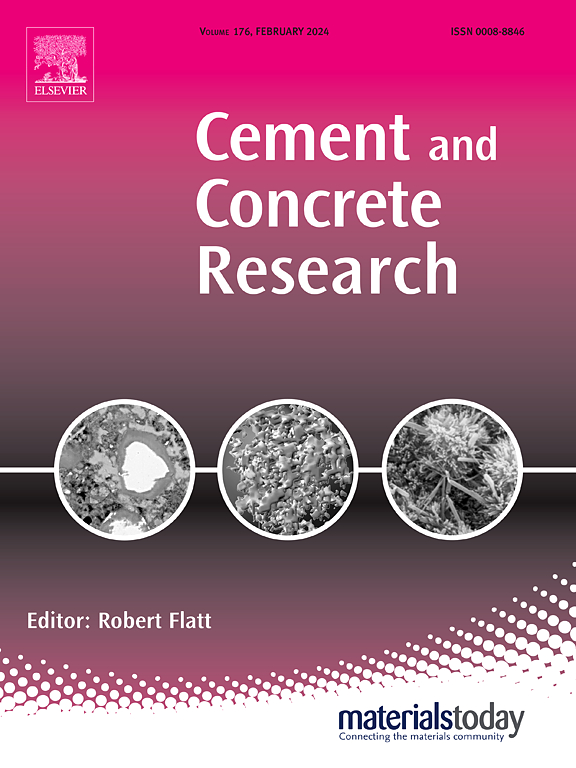游离高效减水剂浓度是影响胶凝体瞬时触变性速率的关键因素
IF 13.1
1区 工程技术
Q1 CONSTRUCTION & BUILDING TECHNOLOGY
引用次数: 0
摘要
触变性是一种流体在应力作用下表观粘度降低,并在可观察到的动力学作用下在应力解除后恢复粘度的特性,它是水泥浆体除塑性(屈服应力或剪切变薄)之外的一个重要特性。这一现象对水泥基材料的可加工性、稳定性和整体性能具有重要意义。了解水泥膏体的触变性对于优化混凝土施工中的放置和整理工艺以及开发具有定制流变特性的先进材料尤为重要。从混凝土放置到增材制造,它是水泥浆料的一个有影响力的特征,可以扩大到全尺寸材料。虽然许多研究将外加剂吸附动力学与滑塌演化联系起来,但本文旨在说明触变性和结构堆积动力学是如何受到影响的。目前吸附工作的第一个结果是,在低剂量和超过5分钟的观察下观察到完全的高效减水剂消耗,这既不符合早期水合物捕获聚合物,也不符合langmuir类机制。在进行吸附测量的同时,获得了流变流动曲线,并根据基于时间演化结构参数的简单框架建立了模型。然后将拟合的模型参数与吸附量随时间的变化进行比较。观察结果表明,在聚合物完全消耗后,结构积聚强烈加速,而悬浮液的最终分散状态急剧下降。另一方面,只要溶液中有足够的聚合物为进一步的吸附提供燃料,最终的分散程度就很高,结构的形成仍然缓慢。这项工作为高效减水剂的作用提供了不同的视角,通过它们的吸附动力学,高效减水剂与纯分散剂一样具有触变性缓释剂的作用。本文章由计算机程序翻译,如有差异,请以英文原文为准。
Free superplasticizer concentration is a key influencer of the instantaneous thixotropy rates of cementitious pastes
Thixotropy, the property of a fluid to decrease in apparent viscosity under stress and recover its viscosity upon stress relief with observable kinetics, is a crucial characteristic in the behavior of cement pastes in addition to plasticity - the presence of a yield stress, or shear-thinning. This phenomenon has significant implications for the workability, stability, and overall performance of cement-based materials. Understanding thixotropy in cement pastes is particularly important for optimizing the placement and finishing processes in concrete construction, as well as for the development of advanced materials with tailored rheological properties. From concrete placement to additive manufacturing, it is an influential feature of cementitious pastes that scales up to the full-scale material. While numerous studies linked the admixture adsorption kinetics to the slump evolution, this paper aims at illustrating how thixotropy and structural buildup kinetics are affected. A first result of the present work on adsorption is that full superplasticizer consumption is observed at low dosages and beyond five minutes of observation, which does neither correspond to polymer capture by early hydrates nor comply to Langmuir-like mechanisms. Simultaneously to adsorption measurements, rheology flow curves were acquired and modeled according to a simple framework based on a time-evolving structural parameter. The fitted model parameters were then compared to the adsorbed amounts over time. The observations show that after the moment of full polymer consumption, structural buildup strongly accelerates while the ultimate dispersion state of the suspensions drops sharply. On the other hand, as long as enough polymer remains in solution to fuel further adsorption, the ultimate dispersion degree is high and structural buildup remains slow. This work sheds a different light on the role of superplasticizers, which behave as thixotropy-mitigators as much as pure dispersants through their adsorption kinetics.
求助全文
通过发布文献求助,成功后即可免费获取论文全文。
去求助
来源期刊

Cement and Concrete Research
工程技术-材料科学:综合
CiteScore
20.90
自引率
12.30%
发文量
318
审稿时长
53 days
期刊介绍:
Cement and Concrete Research is dedicated to publishing top-notch research on the materials science and engineering of cement, cement composites, mortars, concrete, and related materials incorporating cement or other mineral binders. The journal prioritizes reporting significant findings in research on the properties and performance of cementitious materials. It also covers novel experimental techniques, the latest analytical and modeling methods, examination and diagnosis of actual cement and concrete structures, and the exploration of potential improvements in materials.
 求助内容:
求助内容: 应助结果提醒方式:
应助结果提醒方式:


